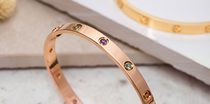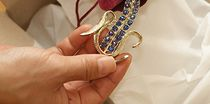A
Amethyst
Amethyst is a semiprecious variety of quartz that has a violet color. This semiprecious stone decorates the rings of bishops and is believed to have protective and curative powers. Amethyst is the birthstone for the month of February.
Aquamarine
Aquamarine is a variety of beryl. Its name comes from the Latin aqua marina, which means ‘sea water’. The color of this cousin of the emerald can indeed range from a nearly transparent light blue to a much darker blue hue. In popular culture, it is considered to be the gemstone of talismans and sailors, and symbolizes fidelity between newlyweds. For this reason, as well as thanks to its delicate, poetic color, aquamarine is traditionally given in engagement rings. It is the birthstone for the month of March.
C
Cabochon
A precious or semiprecious stone that has been polished but not cut into facets.
Carat
The carat is a unit of weight used in jewelry. It is abbreviated as “ct” and is not to be confused with the Karat (K), which is a unit for measuring the fineness of gold. A stone of 0.20 grams weighs one carat.
Citrine
Citrine is a variety of quartz with a lemon yellow color, from which it takes its name. Also called “yellow quartz”, citrine is a rather rare semiprecious stone whose color varies between pale yellow and amber. It is the birthstone for the month of November and is traditionally given for Mother’s Day.
D
Diamond
The diamond is the queen of stones, the most precious of gems. It takes its name from the Medeival Latin diamas, derived from the Greek adamas, which means "the most resistant, indestructible, inalterable". Indeed, the diamond is the hardest stone and even the hardest of all natural materials (with the maximum score of 10 on the Mohs mineral hardness scale). The 4 criteria for evaluating a diamond are the "4 Cs", i.e. Cut, Carat, Clarity and Color.
The main shapes that gem cutters have given to diamonds are the princess, pear, cushion, marquise, heart, baguette, radiant, emerald and brilliant round. A diamond's weight is measured in carats: one carat equals a gem of 0.20 gram. A diamond's purity is determined using a 10x magnifying glass, and is ranked in the following categories from purest to least pure:
“Internally flawless” or “IF” indicates a complete absence of inclusions and absolute purity
VVS1 and VVS2 (very, very small inclusions)
VS1 and VS2 (very small inclusions)
SI1, SI2 and SI3 (small inclusions)
I1, I2 and I3 (imperfections), also called P1, P2, P3 for piqué in French. In this category, the diamond inclusions are visible to the naked eye.
Finally, the color of diamonds is measured using the diamond color grading scale, from the whitest to the most colored:
D - Exceptional white +, “Jager”
E - Exceptional white, “River”
F - Rare white +
G - Rare white +, “Top Wesselton”
H - White, “Wesselton”
I - Slightly tinted white, “Top Crystal”
J - Slightly tinted white, “Crystal”
K - Tinted white, “Top Cape”
L - Faint yellow, “Light Cape”
M - Tinted color 1, “Cape”
From N to Z - Very light yellow to “Dark cape” or “Yellow”
In addition to being "a girl's best friend" and the birthstone for the month of April, the diamond is the timeless gem that we give on very special occasions such as an engagement, a wedding or a 60th wedding anniversary, called the "diamond anniversary"!
E
Emerald
Emerald is a variety of beryl that naturally has an elongated rectangular shape and has lent its name to a special cut, the emerald cut. This gemstone, with its very deep green color, always features inclusions visible to the naked eye that gem specialists also call its "garden". The emerald has always been the gemstone of the world's most powerful people, and today is given for the 20th or 35th wedding anniversaries, and is also used in engagement rings, symbolizing eternal youth. Emerald is the birthstone for the month of May.
g
Garnet
Garnet is a semiprecious stone that is found in a great number of complex varieties, ranging in color from yellow to red, green and black. Blue is the only color garnet is not found in. Thanks to the beauty of its colors and its hardness (7 on the Mohs mineral hardness scale), garnet has long been used to make fine jewelry and today remains an excellent alternative to ruby. Garnet is the birthstone for the month of January.
Gold
Gold is a noble, precious material frequently used in jewelry, ahead of platinum or silver. With a hardness level of 3 on the Mohs scale, compared to 10 for the diamond, pure gold is a malleable material. This is why the types of gold that we are familiar with are alloys of gold and other metals that make it more solid and resistant. Yellow gold is an alloy composed of 75% pure gold, 12.5% silver and 12.5% copper. White or gray gold is an alloy composed of 75% pure gold, silver and sometimes palladium. Rose gold is an alloy composed of 75% pure gold, 20% copper and 5% fine silver.
o
Opal
Opal, a mineral composed of silica, takes its name from the Sanskrit upala, which means "precious stone". There are a great many varieties of opal and it is even said that they can be found in all the colors of the rainbow. There are, nonetheless, 4 main types of opals: the very rare black opal, the fire opal, the boulder opal and the white opal. This gemstone symbolizes purity and is believed to have soothing, protective properties. Opal is given for the 14th wedding anniversary and is the birthstone for the month of October.
P
Pearls
Pearls have been used in jewelry for centuries. In the Antiquity, they were called “Aphrodite’s tears”. Fine pearls or natural pearls form when a foreign body enters an oyster’s shell. When this foreign body enters, the oyster reacts by covering this object with nacre, which accumulates in layers until it forms the pearl nacre layer. The pearls that we find in today’s jewelry making are mainly cultured pearls, which is to say pearls produced artificially by manually inserting a foreign body in the oyster’s shell. There are several categories of pearls: Akoya pearls, Tahitian pearls, Australian pearls, South Sea pearls and others. The quality of a pearl is measured based on its shape, the quality of its surface/shine, also called “lustre”, its size and its color.
Q
Quartz
The different varieties of quartz, which are composed mainly of silica, fall into two distinct categories: macrocrystalline quartz (whose crystals are visible to the naked eye) and microcrystalline quartz (which has microscopic crystals). Macrocrystalline quartzes include rock crystal, rose quartz, citrine, amethyst and smoky quartz. Microcrystalline quartzes include chalcedonies, agates and jasper. The name “quartz” can thus describe any one of these precious stones and generally designates rock crystal, a perfectly transparent stone loved for its sparkle. Quartz is the birthstone for the month of February.
R
Ruby
The ruby, a gemstone whose color ranges from bright red to pink or purple, is a variety of corundum. Its distinct color makes it the symbol of love and passion. For this reason, it is often given in engagement rings and at Valentine’s Day. The ruby is also the second hardest of all stones, after the diamond. The ruby’s red color comes from the presence of element chromium, which also gives the stone its inclusions. The ruby, the gemstone given for the 15th and 40th wedding anniversaries, is the birthstone for the month of July.
S
Sapphire
The sapphire, like the ruby, is a variety of corundum and has a hardness of 9 on the Mohs scale. The name “sapphire” comes from the Greek sappheiros, which means "blue-colored stone" and is also given to other varieties corundum, for example yellow, rose and green sapphires. Nonetheless, the most famous sapphire has a color ranging from lighter blue to royal blue. In popular culture, this gemstone symbolizes stability and fidelity. It is given as a gift for the 16th wedding anniversary and is the birthstone for the month of September.
Silver
The silver mainly used in jewelry is a silver alloy with a millesimal fineness of 925/1000, also called “sterling silver”. The alloy is composed of 92.5% pure silver and 7.5% other metals, mainly copper, added to make the material more resistant and less malleable. It must be cleaned and maintained regularly as it can tarnish. Silver is loved for its white sparkle and its affordable price. It goes wonderfully with most gemstones.
T
Tanzanite
Tanzanite is a rare gemstone that was first discovered in the 1960s. It is a variety of zoisite, which was at the time unknown and was discovered by the Maasai people in Tanzania. This blue stone, which sometimes also appear violet or lavender, thus inherited the name of the country it was found in. Tanzanite is the birthstone for the month of December.
Topaz
Topaz is a precious stone that, in its natural state, is found in a wide range of colors. Among the most sought after is the Imperial Topaz, found mainly in Brazil in its characteristic color ranging from intense golden brown to reddish orange. Certain darker shades can be obtained by heating (pale yellow topazes become rose colored) or irradiation (to bring out the blue). These treatments do not alter the quality of the stone. Topaz is the birthstone for the month of December.
Tourmaline
Tourmalines are semiprecious stones that, depending on their composition, may be yellow, green, rose, orange, gray or even multicolored. The stone is believed to have protective properties and to help strengthen our concentration. However, each tourmaline is said to have its own special properties. For this reason, it is considered to be the gemstone for artists, who love tourmaline’s benefits in terms of creativity and inspiration and is the birthstone for the month of October.
Tsavorite
Tsavorite is a semiprecious variety of garnet. Discovered only in the 1960s, this gem is a newcomer in the world of precious stones. It is named after Tsavo region in Kenya, where it was found for the first time. Its green, which varies from lighter to darker, is always very bright and intense. Tsavorite is a rare stone that is seldom over 1 carat in size and is said to have soothing, protective properties. Like garnet, tsavorite is the birthstone for January.









